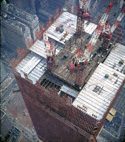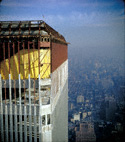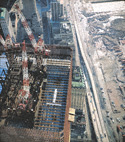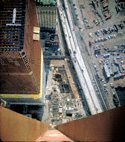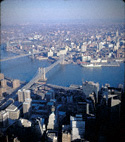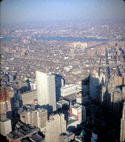Historical
World Trade Center Photographs |
||||||||||||||||
This is a collection of unique photographs taken by Frank E. Schmidt in 1970-1971. They were shot with a 3D camera, and employ a technique called “hyper-stereo.” They include one-of-a-kind images of the World Trade Center as it was being constructed. The photos were taken of one uncompleted tower from the other, before the buildings were opened to the public. Click on an image to see
a larger version, and to see options for viewing in 3D. For more information about
this collection, send an email to: |
|
|||||||||||||||
About Stereo Photography A normal stereo photo consists of a pair of images of the same scene but taken from a slightly different angle. This angle or parallax is needed to give a sense of depth. It is the same depth one sees when viewing objects with both eyes at close range. To see the photo pairs in 3D, each eye must see only the correct side – the right eye the right side, the left eye the left side. The brain combines the two into one. The result is a stereo image. The easiest way to observe a 3D pair of photos is to view the original slides directly through a stereo viewer where each eye sees a different image. This method also provides the highest quality viewing experience. On this web site, you can view regular non-3D versions of these photos. There are also several ways to view them in 3D. The easiest way to view the 3D images is with cheap 3D glasses that have red and blue filters on them. If you don’t have 3D glasses, there are also two methods to “free-view” the stereo image pairs. How can you combine each pair to form a single image without the use of a special device? The procedure is known as ‘free viewing’. The idea is to focus in on the pair and have them blend together. It may take some practice, but the result can be quite spectacular. Come up close as you can to the selected pair of pictures. Don’t focus in on a specific place but rather let your eyes relax, as if you’re looking out into the distance. Try to get the two frames to shift inwards together . You may also have to tilt your head slightly left or right to bring the images in horizontal alignment. If practice on this doesn’t work try this technique: Put a partition, like a small book between the two frames. Then put your eyes up against the other end. The idea is to keep the eyes from seeing the opposite frame. This should combine both pictures into one, resulting in stereo. The selected stereo pairs shown here have been made with an unusually large parallax – up to 200 feet. This procedure known as ‘hyper-stereo’ lends itself well for distant scenes. It tends to, in effect, miniaturize large objects. The method is quite simple. With any camera using any type film, (but preferably slide film for projection) take two separate pictures at the selected parallax (horizontal shift.) Proper centering and alignment is essential. You can then view the two resulting images side-by-side as described above to see in hyper-stereo. |
||||||||||||||||
